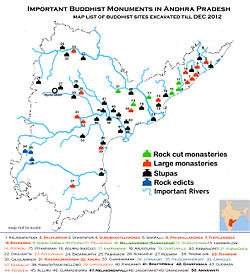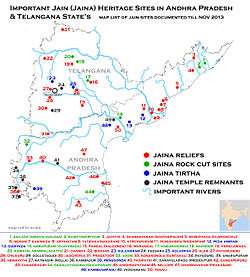Nellore district
Nellore district (officially: Sri Potti Sriramulu Nellore district), is one of nine districts in the Coastal Andhra region of the Indian state of Andhra Pradesh. According to the 2011 Census, the district's population was 2,966,082, of which 29.07% was urban. Its administrative headquarters are located in Nellore city. The district is bordered by the Bay of Bengal to the east, Kadapa district to the west, Prakasam District to the north, and Chittoor district and Thiruvallur district of Tamil Nadu to the south.[3]
Sri Potti Sriramulu Nellore district | |
|---|---|
District of Andhra Pradesh | |
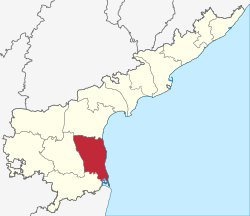 Location of Sri Potti Sriramulu Nellore district in Andhra Pradesh | |
| Coordinates (Nellore): 14°26′N 80°0′E | |
| Country | |
| State | Andhra Pradesh |
| Division | Sri Potti Sriramulu Nellore district |
| Headquarters | Nellore |
| Tehsils | 47[1] |
| Government | |
| • District collector | M. V. Seshagiri Babu IAS[2] |
| • Lok Sabha constituencies | Nellore (Lok Sabha constituency) Tirupati(Lok Sabha constituency) |
| • Vidhan Sabha constituencies | 10 |
| Area | |
| • Total | 13,076 km2 (5,049 sq mi) |
| Population (2011) | |
| • Total | 2,963,557[3] |
| • Urban | 29.07% |
| Demographics | |
| • Literacy | 69.15% |
| • Sex ratio | 986 |
| Vehicle registration | AP-26 (former) AP–39 (from 30 January 2019)[4] |
| Major highways | NH 16 |
| Website | Official website |
The island of Sriharikota, the site where most Indian spacecraft are launched, is located in Nellore district.
Etymology
The name of the district is derived from the name of the district headquarters, Nellore. The district's name was Vikrama Simhapuri until the 13th century, when it became known as Nellore. The name Nellore originates from a mythological story from the Sthala Puranas which depict a lingam in the form of a stone under an amla, or nelli, tree in Nellore. The place gradually became Nelli-ooru (nelli referring to the amla tree and ooru referring to a place in the Proto-Dravidian language) and then present-day Nellore.[5]
The official name of Nellore was changed to Sri Potti Sriramulu Nellore District (SPSR Nellore) on 4 June 2008,[6] in honour of the Indian revolutionary Potti Sri Ramulu, who died fasting in an attempt to achieve the formation of a separate state for the Telugu people, which would later become Andhra Pradesh.[7]
History
Mauryas, early Cholas and Pallavas
With the rise of the Mauryan Empire under Ashoka, many parts of the Andhra Pradesh, including Nellore, came under its influence and became part of the empire in the third century BC. After Mauryan rule, the Chola dynasty ruled the area between the first and the fourth centuries AD. The earliest Chola inscription, from 1096 AD, was found at Jummaluru. The district was part of the empire forged by the first and the most famous Chola, Karikala, who remains well-known for engineering works such as the construction of flood banks on the river Kaveri.
Chola power declined with frequent attacks by the Pallavas, Cheras and Pandyas. The region came under the Pallava rule between the fourth and sixth centuries, after the overthrowal of Chola rule by Simha Vishnu Pallava. With the dawn of the seventh century, the Pallava political centre shifted to the south, leading to a weaker presence in the north, including in Nellore. Nonetheless, Pallava rule left its mark on Nellore. Several ancient Pallava and Chola temples can be found in Udayagiri village, while inscriptions about Pallava rule were discovered in the Guntur-Nellore tract of Andhra Pradesh. The four-storeyed cave at Vundavalli and eight-cave temple at Bhairavkonda resemble Pallava architecture during the period of Mahendravarma, a Pallava king.
Nellore Chola kings
The Cholas regained power in the ninth century; this period marked the peak of Nellore's political power. Tikkana Somayaji, a minister and Telugu poet who translated the Mahabharata into Telugu, gave a historical account of the Chola family in his book Nirvachanottara Ramayanamu. A branch of the Telugu Cholas, who were feudatories of the Western Chalukyas of Kalyani, were appointed as rulers of Pakanadu (modern-day Kadapa, Nellore and southern Prakasam districts) for their assistasnce in the war between the Cholas and Chalukyas. They ruled over the region consisting of the Nellore, Kadapa, Chittur and Chengalput districts with Vikramasimhapuri (modern-day Nellore) as their capital.
Tikka (r. 1223–1248), a Nellore Chola king, defeated both the Hoysala and the Pandyas and conquered the Tondaimandalam region, assuming the title of Cholasthapanacharya. During the reign of Tikka's son and successor Manumasiddhi II (1248–1263), Nellore faced several attacks from other Chalukyas and Pandyas. Tikkana visited Ganapati of Kakatiyas and gained military support for his king. Around 1260, a feud over cattle grazing rights in certain meadows broke out between Manumasiddhi and Katamaraju, the chief of Erragaddapadu in Kanigiri region. It led to a bloody battle being fought at Panchalingala near Muttukuru on the coast of river Penna, resulting in a victory for Manumasiddhi's forces. This feud and the consequent battle formed the theme for the popular ballad called "Katamaraju Katha". Manumasiddhi died during or shortly after the battle, resulting in Nellore's loss of significance.
Kakatiyas, Pandyas and Vijayanagara rulers
Under the leadership of Prola, the Kakatiyas, feudatories of the Western Chalukyas of Kalyani, declared their independence. Ganapati Deva, the first great Kakatiya king, brought most of the Telugu area under his rule, including Nellore in the thirteenth century. Nellore changed hands between the Kakatiyas and Pandyas multiple times until the Kakatiyas emerged victorious under Prataprudra II. After the fall of the Kakatiya Empire, Nellore came under the rule of the Tughlaq Dynasty and then the Reddi Kingdom.
Most parts of the district were annexed by the Sangama dynasty of the Vijayanagara empire in the fourteenth century. The remaining portions of the district, including Udayagiri, were conquered by Krishnadeva Rayalu in 1512. The ruins of a fortress built by the Vijayanagar kings in the fourteenth century can still be seen at Udayagiri.
The Nawabs and the British period
After the fall of the Vijayanagara Empire, the area was ruled by the Nawabs. During the eighteenth century, Nellore saw wars between Najeebullah, the ruler of the area, and his brother Arcot Nawab, who received support from the British and French. Nawab's army, under the command of colonel Caillaud, took over the Nellore fort in 1762. For the purposes of revenue collection, the town of Nellore and the surrounding district were handed over to the British East India Company in 1781 and 1801, respectively. Nellore was named the revenue unit for the district.[8]
During the British period, the district's jurisdiction did not undergo any major changes except for the transfer of Ongole taluk to the newly-formed Guntur district in 1904.
Post Indian Independence
After India gained indpendence in 1947, Nellore became part of the Madras state until 1 October 1953. On 1 November 1956, when Indian states were reorganised on a linguistic basis, the district became part of the newly-formed Andhra Pradesh state. Potti Sriramulu, a Nellore-born Telugu activist, died during a hunger strike while advocating for the formation of Andhra Pradesh state.
Nellore has produced two former chief ministers: Bezawada Gopala Reddy and Nedurumalli Janardhana Reddy. The district's main political parties are YSR Congress and Telugu Desam Party. Communist parties in Nellore have more followers compared to those of neighbouring districts like Kadapa and Ongole. Puchalapalli Sundaraiah, a founding member of the Communist Party of India (Marxist), attempted to establish communism in Nellore.
In 1970, the northern parts of Nellore district were transferred to the newly-created Prakasam district.[9]

Epigraphical records
In Nellore district, there exist a variety of Telugu inscriptions originating from several different kingdoms. Tamil inscriptions also exist near the Mallam Subramanyeshwara Swamy temple, which was constructed by Rajendhra Chola during the fourteenth century.[10][11][12]
Geography
Nellore district is bordered by the Bay of Bengal to the east, the Chittoor district in Andhra Pradesh and Tiruvallur district in Tamil Nadu to the South, Cuddapah district to the west and north-west, and Prakasam district to the north.
The district's average elevation is 19 metres (62 feet). Eastern Nellore consists of an area of low-lying land extending from the base of the Eastern Ghats range to the Bay of Bengal, while the western side is comparably more mountainous and is separated from neighbouring Cuddapah district by the Velikonda hills, part of the Eastern Ghats.
25.96% of Nellore's land area is cultivated, while 17.75% is cultivable but fallow. The remainder consists of land used for non-agricultural purposes (18.68%), forested land (20.09%) and barren land (10.56%) unsuitable for human cultivation.[13][14] The Pennar, Swarnamukhi and Gundlakamma are the main rivers that flow through the district. These rivers, in addition to the Penna's tributaries, including the Kandaleru and Boggeru rivers, are not navigable and mainly serve to irrigate nearby farmland. Nellore is rich in a particular type of flint known as quartzite, which prehistoric humans used to make weapons and implements.
Climate
Maximum temperature occur during the summer at 36 to 46 °C (97 to 115 °F), while the minimum temperature occurs during the winter at 23 to 25 °C (73 to 77 °F). The average annual rainfall of the district is 1,080 mm (43 in), and reaches its peak during the southwest and northeast monsoons. Nellore is subjected to both droughts and floods, depending on the seasons.[14]
Demographics
| Year | Pop. | ±% p.a. |
|---|---|---|
| 1901 | 884,751 | — |
| 1911 | 901,771 | +0.19% |
| 1921 | 939,647 | +0.41% |
| 1931 | 1,015,946 | +0.78% |
| 1941 | 1,098,145 | +0.78% |
| 1951 | 1,226,155 | +1.11% |
| 1961 | 1,408,891 | +1.40% |
| 1971 | 1,627,740 | +1.45% |
| 1981 | 2,014,879 | +2.16% |
| 1991 | 2,392,260 | +1.73% |
| 2001 | 2,668,564 | +1.10% |
| 2011 | 2,963,557 | +1.05% |
| source:[15] | ||
According to the 2011 census, Nellore district had a population of 2,963,557,[16] which ranked it at 126 out of 640 districts of India.[16] The district has a population density of 227 inhabitants per square kilometre (590/sq mi).[16] Its population grew by 11.15% between 2001 to 2011.[16] Nellore district had a sex ratio of 986 females for every 1000 males,[16] and a literacy rate of 69.15%.[16]
Telugu is the official language and is widely spoken in Nellore. Urdu is the second most-spoken language. Tamil is spoken by the minority Tamil people, who mostly reside in the south of the district, near the border of Tamil Nadu state.
Economy
The Gross District Domestic Product (GDDP) of Nellore district is ₹30,482 crore (304.82 billion rupees) and makes up 5.8% of Andhra Pradesh's Gross State Domestic Product (GSDP). For the fiscal year 2013–14, Nellore's per capita income at current prices was ₹80,782 (US$1,100). The primary, secondary and tertiary sectors of the district contribute ₹9,729 crore, ₹6,320 crore and ₹14,433 crore (97.29 billion, 63.2 billion and 144.33 billion rupees), respectively.[17] The major agricultural contributors to the district's gross value added (GVA) include: paddy, sugarcane, lemon, tomato, milk, meat and fisheries. The major industrial and service contributors to the district's GVA include: construction, electricity, manufacturing, transport and education.[17]
Administrative divisions
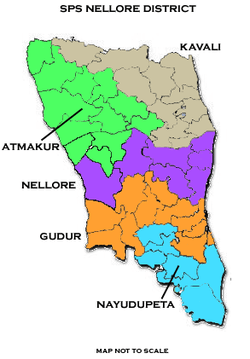
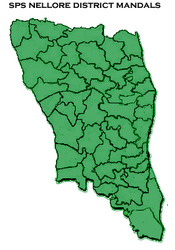
The district has five revenue divisions, each of which is headed by a sub-collector: Atmakur, Naidupet, Nellore, Gudur and Kavali.[20][21] These revenue divisions are divided into 46 mandals, which consist of 1,177 villages and 12 towns (urban settlements). Nellore's twelve urban settlements include six statutory towns and six census towns. The statutory towns consist of one municipal corporation (Nellore) and six municipalities (Atmakur, Gudur, Kavali, Sullurpeta, Naidupeta and Venkatagiri).[20] The five census towns are Buja Buja Nellore, L.A. Sagaram, Tada Khandrika, Vinnamala, and Yerrabalem.[22]
Mandals
The following table lists the 46 mandals in Nellore district by their revenue division:[20][21][22]
Culture
Art and literature
Bara Shaheed Dargah (Urdu: Shrine of Twelve Martyrs) is located in Nellore and is visited by lakhs (tens of thousands) of people each year. The Rottela Panduga is a festival held at the shrine.
The Nellore region has produced several notable Telugu artists. Ancient Telugu poets include Tikkana, Molla, Marana, and Ketana, who laid the foundations for Telugu literature. Tikkana, the second of the Kavitrayam, a trio of Telegu poets, translated the Sanskrit epic Mahabharat into Telegu. Molla, the second Telugu poetess, translated Ramayan into Telugu. Ketana, a disciple of Tikkana, dedicated his work called Dasakumara Charitram to Tikkana. Ketana also wrote Andhrabashabushanam, a Telugu grammar book. Marana, another poet, and disciple of Tikkana wrote Markandeya Puranam. Ramarajabhushanudu from this region was patronised by Krishnadevaraya. Poet Gunturu Seshendra Sarma is also from this region
The popular entertainment in the region are movies and related activities. S. P. Balasubrahmanyam, one of India's top singers, was born in Nellore. Telugu lyricist Acharya Atreya is from this region. Pattabhirama Reddy Tikkavarapu, a poet and director from Nellore, wrote Ragala Dozen (A Dozen Melodies), a collection that recorded his observations in Madras and Nellore. He also produced the Telugu film, Pellinaati Pramanalu, and directed films Samskara, Chandamarutha, Sringaramasa, and Devara Kaadu.[23] Nellore also is the origin of many Telugu actors including Rajanala, Ramana Reddy, and Vanisree, playback singers like S. P. Balasubramanyam, S. P. Sailaja. V. T. Venkataram, a famous consumer activist, hails from Nellore.
Notable personalities
Notable politicians include, Nedurumalli Janardhana Reddy, chief Minister of Andhra Pradesh from 1990 to 1992; Bezawada Gopala Reddy, Chief Minister of Andhra state from 1954 to 1956; Puchalapalli Sundaraiah, founding member of the CPI (M), Alladi Krishnaswamy Iyer ;Smt.Panabaka Lakshmi , former Union Minister Muppavarapu Venkaiah Naidu-Vice President of India; film industry include, Singeetam Srinivasa Rao, S. P. Balasubrahmanyam, A. Kodandarami Reddy, S. Thaman, M. S. Reddy, A. M. Rathnam; Vanisree; Ponaka Kanakamma, social worker and activist; Gunturu Seshendra Sarma, a poet; Malli Mastan Babu- Indian Mountaineer; Sethu Madhav Kishore- Doctor Babu.
Transport
The total road length of state highways in the district is 1,226 km (762 mi).[24] National Highway 16 paases through the city.
Krishnapatnam Port is an important port situated in the district on the Bay of Bengal.[25] Dugarajapatnam Port is a proposed port in the district.[26]
Education
The primary and secondary school education is imparted by government, aided and private schools, under the School Education Department of the state.[27][28] As per the school information report for the academic year 2017–18, there are a total of 4,489 schools. These include: 21 government, 3,140 mandal and zilla parishads, 2 residential, 1,077 private, 10 model, 10 Kasturba Gandhi Balika Vidyalaya (KGBV), 106 municipal and 123 other types of schools.[29] The total number of students enrolled in primary, upper primary and high schools of the district are 3,95,092.[30]
References
- "District – Guntur". Andhra Pradesh Online Portal. Archived from the original on 8 June 2015. Retrieved 29 August 2014.
- "Days after assuming office, Jagan rejigs administration in AP". Asian News International. 5 June 2019. Retrieved 5 June 2019.
- "Nellore district profile". Andhra Pradesh State Portal. Archived from the original on 15 July 2014.
- "New 'AP 39' code to register vehicles in Andhra Pradesh launched". The New Indian Express. Vijayawada. 31 January 2019. Retrieved 9 June 2019.
- Staff, Government Of Madras; Madras, Government of (1 January 1942). Gazetteer of the Nellore District: Brought Up to 1938. Asian Educational Services. ISBN 9788120618510.
- https://spsnellore.ap.gov.in/nellore-district-profile/
- "The martyr of Telugu statehood". The Hindu. Chennai, India. 11 November 2002.
- Nellore became revenue unit Archived 6 March 2016 at the Wayback Machine. Telugupeople.com. Retrieved on 13 June 2012.
- Law, Gwillim (25 September 2011). "Districts of India". Statoids. Retrieved 11 October 2011.
- Sewell, Robert (17 May 1882). Lists of the Antiquarian Remains in the Presidency of Madras. E. Keys, at the Government Press. p. 324 – via Internet Archive.
telugu inscriptions in nellore.
- "Copper Plate and Stone Inscriptions of South India 3 Vols. 1st Edition : Printsasia.in". www.printsasia.in.
- "Social Scientist, issues 269-71, Oct-Dec 1995, page 10. -- The Social Scientist -- Digital South Asia Library". dsal.uchicago.edu.
- NELLORE WASTELANDS INFORMATION -AREA IN Sq.Mts (sic). rd.ap.gov.in
- https://nellore.cdma.ap.gov.in/en/district-profile. Missing or empty
|title=(help) - Decadal Variation In Population Since 1901
- "District Census 2011". Census2011.co.in. 2011. Retrieved 30 September 2011.
- "Economy of Nellore District". Andhra Pradesh Economic Development Board. Retrieved 25 April 2017.
- Records, The Daily (15 February 2018). "Top 10 Largest Mica Producing States in India". The Daily Records. Retrieved 21 March 2018.
- "Indian Minerals Yearbook 2013 (Part- III : Mineral Reviews)" (PDF). http://ibm.gov.in. Retrieved 21 March 2018. External link in
|website=(help) - "Geographic Information". Nellore District Official Website. Archived from the original on 31 January 2015. Retrieved 22 October 2014.
- "Ten new revenue divisions created". The Hindu. Hyderabad. 4 April 2013. Retrieved 31 October 2014.
- "District Census Handbook – Sri Potti Sriramulu Nellore" (PDF). Census of India. p. 26,56. Retrieved 18 January 2015.
- Fruits of labour. Hindu.com (18 February 2005). Retrieved on 2012-06-13.
- "Existing State Highways" (PDF). Andhra Pradesh Road Development Corporation. Government of Andhra Pradesh. p. 1. Archived from the original (PDF) on 20 September 2018. Retrieved 11 May 2019.
- "Krishnapatnam Port Company Ltd". krishnapatnam.com.
- "Decks cleared for Dugarajapatnam port". The Times of India.
- "School Education Department" (PDF). School Education Department, Government of Andhra Pradesh. Archived from the original (PDF) on 27 December 2015. Retrieved 7 November 2016.
- "The Department of School Education – Official AP State Government Portal". www.ap.gov.in. Archived from the original on 7 November 2016. Retrieved 7 November 2016.
- "School Information Report". Commissionerate of School Education. Government of Andhra Pradesh. Archived from the original on 8 November 2016. Retrieved 8 November 2016.
- "Student Information Report". Commissionerate of School Education. Child info 2015–16, District School Education – Andhra Pradesh. Archived from the original on 22 May 2015. Retrieved 8 November 2016.
Further reading
- History of Andhras up to 1565, Durga Prasad, P. G. Publishers, Guntur.
- Samagra Andhrula Charitram
